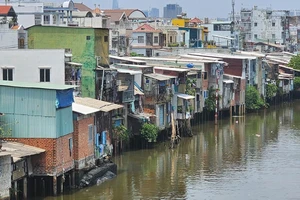Outdated city planning regulations and unrealistic plans have become barriers for the development of Ho Chi Minh City for several years. Most of decade lasting plans have the same characteristics that are unfeasible and short of resources to implement.

Binh Quoi-Thanh Da urban area in Binh Thanh district has been planned for the last 20 years and changed investors twice but has yet to take off.
Long lasting plan causes local citizens unable to repair houses and conduct property trades. Meantime, this area is one of the lowest lying areas of the city, where houses have regularly been submerged with rainwater and tidal floods.
For recent years, the city has permitted locals to repair and build houses. However, they have met with difficulties in applying for land and house ownership certificates because this work has been stagnant for a long time.
Investor of Binh Quoi-Thanh Da project Bitexco Group has many times affirmed with the city’s leaders that they were affordable for carrying out the project.
However, the public has raised doubts about its ability to develop the urban area. The company has so far built some items of another project in a so called ‘diamond’ land plot in front of Ben Thanh Market for the last five years.
Bitexco has seemed to be fumbling about implementing other projects such as 10 hectare Ma Lang site which the city has assigned it to be investor since 2006.
The city People’s Council has issued Resolution 16 on urban planning, implementation and management to deal with planning failure which has negatively affected residents’ lives.
The resolution has yielded results with over 500 failure plans being removed and road limits of nearly 300 streets have been reconsidered. A more feasible 1/2000 scale plan has been mapped out to cover the entire city, creating an important legal basis for urban construction and development.
Besides, the city People’s Committee has issued new policies permitting citizens to repair and build houses if plans are not implemented after three years.
Outdated regulations
Deputy head of the HCMC Institute for Development Studies Hoang Minh Tri said that planning must comply with a set of regulations given by the Ministry of Construction. These regulations clarify areas for trees, parks, roads, health clinics, and schools in each project, the area depends on projects scale.
These regulations have been feasible for new urban area plans not improvement of long existing residential areas because they require site clearance to ensure tree, park, road, school and hospital area.
HCMC has many times talked about the issue to the Ministry of Construction and been responded that the city should apply the regulations flexibly.
Afterwards, the city has instructed the Department of Planning and Investment and districts to review and change plans to improve their feasibility. This has worked to Tay Bac urban area for instance.
According to the change, stable residential areas where citizens have resided for a long time will be kept unchanged. Authorized agencies just build a mechanism to manage their construction, meaning citizens can build and repair houses in accordance with regulations towards modern urban areas.
Parks, hospitals and other facilities will be built in sparsely populated areas to harmonize benefits of citizens and development demand of the city.
These are some of measures the city has applied to reduce the impact of planning failure to citizens’ lives. However, those with houses under planning have still met with disadvantages in selling their properties and doing land procedures.
On the other hand, real estate businesses said that HCMC has hardly had incentives to boost investment in areas where it wants to develop.
An unnamed business said that investors have mainly chosen investment places on their own. Finding good locations, they will ask authorized agencies’ permission to invest there.
They usually choose places with built technical infrastructures or crowded population in order to quickly reclaim their capital and seek profit. Many investors have queued up to invest in the overloaded center area of the city. For instance Phu My Hung new urban area has been surrounded with many real estate firms.
As a result, the city has been unable to reduce population density in the center area and form satellite urban areas in accordance with its plan by 2025.
























